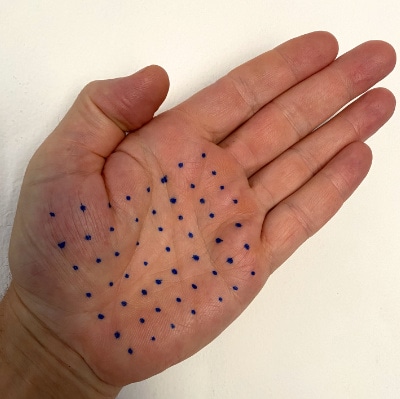Botox for Excessive Sweating at a Glance
Botox is a proven and effective treatment for hyperhidrosis, or excessive sweating.
Botox injections block the signals that stimulate sweat glands, reducing sweat production in the treated areas.
The treatment is commonly used for underarm sweating but can also be effective for palms, soles, and other areas.
Botox provides temporary relief, with results lasting several months, and subsequent treatments can maintain the effects.
Treatments with Botox for hyperhidrosis are typically performed using a local anesthetic to ensure patient comfort during the procedure.
Botox for excessive sweating starts at approx. €570 (indicative price, individual billing according to GOÄ fee schedule).

Everything About Botox for Excessive Sweating: The Topics
Botox for Excessive Sweating
The Limitations of Previous Approaches
In the past, various pharmacological therapies were employed to address hyperhidrosis, a condition characterized by excessive sweating. When these treatments proved ineffective, surgical removal of sweat glands was sometimes considered as an option. However, it’s important to note that such surgical interventions carry the potential for uncomfortable side effects and inherent risks.
Botox: A Safer and More Effective Alternative
Fortunately, medical advancements have provided a safer and more effective alternative in the form of Botulinum toxin, commonly known as Botox. While Botox is widely recognized for its cosmetic applications in wrinkle treatment, it has also demonstrated remarkable efficacy in inhibiting sweat production for individuals with hyperhidrosis. By blocking the transmission of nerve signals to muscles, including those connected to sweat glands, Botox effectively reduces sweat secretion.
Precise and Minimally Invasive Procedure
The administration of Botox injections offers several advantages over traditional treatments. One significant benefit is the minimally invasive nature of the procedure. Compared to surgical options, Botox treatment involves a series of precise injections, typically performed in the targeted areas affected by excessive sweating, such as the underarms, palms, or soles of the feet.
Restoring Quality of Life
Following Botox treatment, many individuals experience a notable improvement in their quality of life. The relentless cycle of dealing with constant sweat outbreaks and the associated discomfort is effectively disrupted. Activities that were once accompanied by embarrassment or self-consciousness due to visible sweat stains can now be undertaken with greater confidence and freedom.
Long-Lasting Relief with Maintenance Treatments
The duration of Botox’s effects can vary from person to person, but on average, the benefits of the treatment can be expected to last for approximately six months. This prolonged period of relief allows individuals to enjoy an extended respite from the challenges posed by hyperhidrosis. Over time, as the effects gradually diminish, a follow-up treatment can be scheduled to maintain the desired level of sweat reduction.
Transforming Lives, Inside and Out
It is important to emphasize that successful treatment of hyperhidrosis with Botox not only addresses the physical symptoms but also has a significant positive impact on mental and emotional well-being. The restoration of self-assurance and the ability to engage in social and professional activities without the constant worry of excessive sweating can be truly transformative.
Expert Consultation for Personalized Care
Consulting with a qualified healthcare professional experienced in administering Botox for hyperhidrosis is essential to ensure the proper assessment and tailored treatment plan for each individual. Through this innovative therapeutic approach, the burden of hyperhidrosis can be significantly alleviated, allowing individuals to reclaim their lives and embrace newfound confidence.
Other Treatment Options
Botox therapy may not be suitable for everyone. In some cases, it may be necessary to consider alternative treatment approaches, such as:
Antiperspirants
These products contain active ingredients like aluminum chloride that temporarily block sweat glands, reducing sweat production. Antiperspirants are available in various strengths and can be a good option for individuals with mild to moderate hyperhidrosis.
Iontophoresis
This treatment involves passing weak electrical currents through water in which the affected body parts, typically hands or feet, are immersed. The electric current helps reduce sweat gland activity. Iontophoresis can be an effective method for treating hyperhidrosis on the hands and feet, but it requires multiple sessions and possibly ongoing maintenance.
Medications
In some cases, prescription medications like anticholinergics may be used to treat hyperhidrosis. These medications block the action of the neurotransmitter acetylcholine, which activates sweat glands. However, anticholinergics can have side effects such as dry mouth, constipation, and blurred vision.
Psychological Therapy
Since stress and anxiety can worsen sweating, working with a psychologist or therapist to manage stress and anxiety can be helpful. Techniques like relaxation exercises, cognitive-behavioral therapy, and biofeedback can help reduce the stress that contributes to excessive sweating.
Endoscopic Thoracic Sympathectomy (ETS)
This surgery involves cutting or blocking the nerves that activate sweat glands. ETS can be effective for severe cases of hyperhidrosis, especially when other treatment methods have been unsuccessful. However, there are risks and potential side effects, such as compensatory sweating in other areas of the body, which need to be carefully weighed.
The choice of the right treatment for hyperhidrosis depends on the severity of the condition, the affected body region, and the individual needs and preferences of the patient. It is important to work with an experienced physician to find the best solution for your situation and enable a life free from excessive sweating.
Conclusion: Botox for Excessive Sweating
In conclusion, Botox has emerged as a highly effective treatment option for excessive sweating, medically known as hyperhidrosis. This non-surgical approach offers significant relief and can greatly improve the quality of life for individuals struggling with this condition.
Through its ability to inhibit nerve signals to the sweat glands, Botox effectively reduces sweat production in the targeted areas. The treatment is minimally invasive and generally well-tolerated, with minimal downtime and quick recovery. Many patients experience a noticeable improvement in their sweating within a few days to weeks after the procedure.
Botox treatment for hyperhidrosis has demonstrated long-lasting results, typically lasting between four and six months before a follow-up treatment is needed. This duration may vary depending on individual factors. Regular maintenance sessions can help sustain the benefits over an extended period.
By effectively controlling excessive sweating, Botox allows individuals to regain confidence and take back control of their lives. It enables them to engage in social activities, wear their favorite clothing without worry, and enjoy improved personal and professional interactions.
If you are struggling with excessive sweating and it is significantly impacting your daily life, it may be time to consider Botox as a viable treatment option. Consult a qualified healthcare professional who specializes in this area to determine if Botox is suitable for you.
At LIPS and SKIN in Munich, we are committed to providing personalized care and delivering optimal results for our patients. Contact us today for complementary information or schedule a consultation and take the first step towards a sweat-free future.

About the author:
Dr. med. univ. Eva Maria Strobl is the owner of LIPS and SKIN Aesthetic Medicine practice in Munich. She is a trained specialist in general medicine (MedUni Vienna) and has over 10 years of specialization in non-surgical aesthetic procedures. She is a member of the German Society for Aesthetic Botulinum Therapy e.V. (DGBT), the German Society of Anti-Aging Medicine e.V. (GSAAM) and of Network Global Health. She publishes regularly on her blog and on DocCheck.

